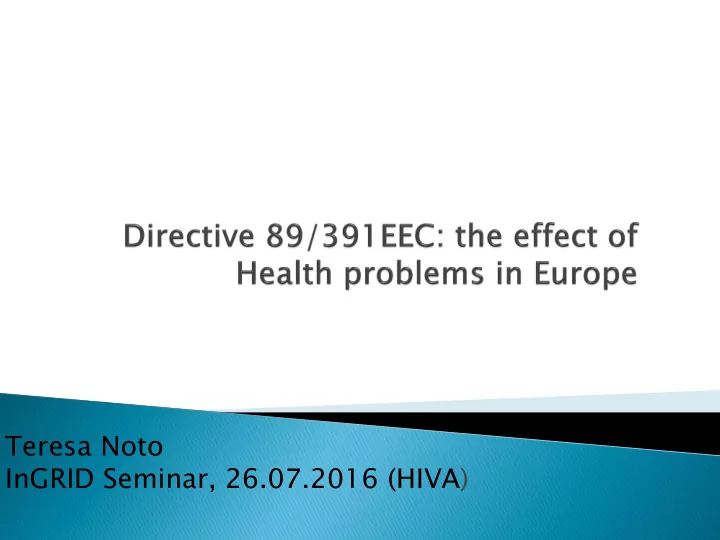

Teresa Noto InGRID Seminar, 26.07.2016 (HIVA)
Research question Materials and methods - European legislation - Literature review - Data analysis Progress developed the InGRID/HIVA visiting Future work The aim of the project
Does Does Framewor work k Directive ive 89/391 91 EEC C reduce the health proble lems ms at at wo work in the EU ? Aim of the research: Understanding whether the European Legislation improve health, safety, and working condition at work in Europe. Materials and methods: European legislation, literature review and data analysis
The interpretation of the Directive 89/391 steers towards an idea of: - Primary prevention (aimed at avoiding the risks before they occur in the workplace, (Art. 3 and Art. 6.) - General principles of prevention , targeting all aspects of the work situations (Art. 3) - Programmed prevention thought out before and in general terms and not periodically (Art. 6, Par. 2, Lett. G) or following demanding events to the health of workers
The communication stated that there was evidence of the positive influence of EU legislation on national standards for OHS but at the same time, the report highlighted various flaws in the application of the legislation that were holding back achievement of its full potential. It also noted cases where infringement proceedings had been opened.
Three different groups: Member State with old or inadequate legislation: 1. Gr Greece, , Ireland, d, Portuga gal, l, Spain, , Italy, , Luxembo mbourg urg Member State with existing national legislation to 2. be refined: Austria ria, , France ce, , Ge Germany, , Belgium, ium, Netherl rland ands, s, United Kingdom om Member State with rules in line with directive: 3. Denmark, Finland, and, Sweden
The implementation strategy of the directive avoiding risks evaluating the risks Reduce uce risks at work combating the risks at source adapting the work to the individual adapting to technical progress replacing the dangerous by Improve the the non- or the less dangerous workp kplace ace developing a coherent overall prevention policy prioritizing collective protective measures (over individual protective measures) Increase rease the equipme ipment nt protecti ction on giving appropriate instructions to the workers Increase ase the informa mati tion on and the worke kers rs safety ty perce cepti tion
Test: Directive 89/391 1. Goal: Reduce health problems 2. Means: 3. Reduce e the risks s at w work Improvem vement ent the workplace ce Increase se the equipment ent protec tecti tion on Increase se the informa rmati tion on and t the worker ers s safety ety percep eption tion European Working Condition Survey EU15 Period: 2000-2005-2010 3 Cluster countries after communication 2004: clusterbad (1group) – clustermedium(2group) – clustergood(3group)
Descript iptive ive statis istic tics • Univar ivariate iate analysis sis healthprob year of survey lem 2000 2005 2010 Total No 1,703 211 5,190 7,104 23.97 2.97 73.06 100.00 13.09 3.94 23.21 17.45 Yes 11,309 5,138 17,169 33,616 33.64 15.28 51.07 100.00 86.91 96.06 76.79 82.55 Total 13,012 5,349 22,359 40,720 31.95 13.14 54.91 100.00 100.00 100.00 100.00 100.00
• Bivar aria iate te analysis ysis The second step is an analysis of bivariate relationships between variables. Bivariate analysis, health problems variable and: Age variable sex variable type contract variable sector variable
Researchers have examined the role of perceptions of workplace safety in understanding the industrial accident process (Guastello & Guastello, 1988; Murphy, Sturdivant, & Gershon, 1993). There are clear differences in job quality and work well-being by the type of job contract (M. Kauhanen & J. Nätti, 2015, Pirani & Salvini, 2015) EU – OSHA (last campaign for older workers, risks about young people and women)
• Bivariate ate analys ysis Health th problems and type of of contract ract healthprob q7_lt. type of contract (long trend) lem an indefi a fixed t a tempora an appren other Total No 4,597 610 120 78 453 5,858 78.47 10.41 2.05 1.33 7.73 100.00 17.28 17.52 21.05 23.78 20.46 17.65 Yes 22,006 2,871 450 250 1,761 27,338 80.50 10.50 1.65 0.91 6.44 100.00 82.72 82.48 78.95 76.22 79.54 82.35 Total 26,603 3,481 570 328 2,214 33,196 80.14 10.49 1.72 0.99 6.67 100.00 100.00 100.00 100.00 100.00 100.00 100.00
Futur ure e Work • Multiv tivari ariate ate analysi ysis s Dependent variable: WORK AFFECTS HEALTH Explanatory variable: CLCOUNTR x COMMUNICATION stage1 Control variables: clcountr, demographics, contract Stage2 Mediating variables: implementations (risks, information, equipment, workplace improvement) Stage3 Interaction effect: split by gender/age.. Stage 4
Mult ltip iple le re regr gression sion model 1. 1. Health= ß˳+ ß risks+ ßinfo+ ßequi+ ß worpl+ ϵ explanatory variable and mediation variables age variable sex variable type contract variable Background workers variables sector variable Interaction Control variables variables
Differe erence-in in-Di Diff ffer erences ences Estim imation ation Data varies by o clcoun (i) o time (t) o Outcome is Work affects Health o Only two periods {before-after – in fact you could also check effect in a third period] Three key variables ◦ T it it = the clustercountry that will eventually be treated ◦ A it it = the times when treatment occurs ◦ T it it A it it = interaction term, treatment after the intervention Y it it = = β 0 + + β 1 T it it + + β 2 A it it + + β 3 T it it A it it + + ε it it
Differen rence ce-in in-Diffe fferences rences Estimat atio ion
WHealth= ß clcountr+ ß time+ ß clcountr∙com04 stage1 + control variables WHealth= ß clcountr+ time+ ß clcountr∙com 04+ßage ß +sex.. Stage2 + explanatory varaibles WHealth= ß clcountr + ß time+ ß clcountr∙ com04+ ß risks+ ßinfo+ ßequi+ ß worpl Stage3
Recommend
More recommend